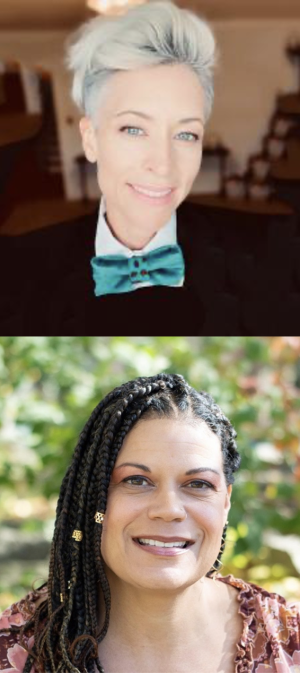Resources by M. Wolff

When the mundane becomes formidable, it signals lack of access.[1] For a trans person, it is precisely the perfunctory mechanics of the classroom that frustrate teaching and learning. This begins with introductions. The trans professor and student immediately must negotiate whether to share their name in class. Is it safe to share that information at the outset, or do we need time to build trust? Are intake forms and classroom norms enough of a safeguard? Toilets pose another pragmatic concern. Trans teachers and students might feel pressure to map out gender-neutral or single-stall restrooms prior to class to avoid quizzical glances or worse. Depending upon the campus, these facilities might be few and far between, meaning a menstruating trans man might have to leave class for an extended period of time in order to refresh his sanitary products. Instructors and students might be caught off guard by blatant transphobia. It arises in verbal comments, required readings, and even student papers. Syllabus policies for the prevention of misgendering classroom participants and authors of required readings is a good starting place, but it is clear that much more is needed. What trans-informed changes to institutional email addresses, for example, prevent the use of deadnames? [2] All of these examples are especially charged when linked to religion. The landscape is brutal: “2023 marks the fourth consecutive record-breaking year for total number of anti-trans bills considered in the U.S.”[3] Student-athletes face discrimination inside and beyond locker rooms while faculty seek equal access to restrooms and parental leave. Educators are wondering how to respond ethically. But beware. The instrumentalization of trans embodiment as a wedge issue within political discourse, especially as linked to religion, further disenfranchises trans persons. We learned this lesson in the 1970’s when abortion was similarly leveraged as a smokescreen for racially segregating schools, subsequently polarizing American politics.[4] Anti-trans bills likewise pit one person against another, supposedly in the name of God. To focus on the bills is to walk into a carefully set trap, allowing embodiment to be confused with essentializing materiality and reduced to identity politics. We need to reorient the representation of trans persons beyond trans issues, in part by using resources such as the Trans Journalistic Association style guide.[5] Whatever the subject of the course, contemplating trans perspectives and reading trans scholarship is valuable. Be it ecology, the prison industrial complex, or housing access, trans persons have insightful contributions—to the study and practice of religion as much as medicine and economics. Importantly, the onus cannot fall squarely on the instructor, especially when the instructor is trans. Many of the obstacles we face are due to the built environment, which is beyond our control. I would like to invite readers to consider what collective action might entail. Here I propose personal and political ethical action that neither falls prey to strategic discourses of entrapment nor neglects the practicality of embodied teaching. My shorthand for this recommendation is compassionate curiosity. In place of hypothetical scenarios, like the trolley problem or lifeboat scenario that frequent ethical inquiry, compassionate curiosity bonds classroom communities through deep soul work intended for societal transformation.[6] Compassionate curiosity solicits us to communicate with one another and discern what is most pressing within the particularities of our contexts. There is no individual or action that can bear the weight of transphobia. We need one another. With students and colleagues, practice compassionate curiosity by considering: Are there trans leaders on campus and in course material? What policy changes on and off campus would be worth prioritizing? How can we establish trans mentoring networks in religious education? Let’s ask students what changes they would like to see on campus and how they might initiate those. Explore what is important to each particular classroom of students and also share the needs of instructors. If the challenges that we face are systemic, our responsibility is not for individuals to hustle harder. Improving the classroom environment requires collaboration. Practicing compassionate curiosity in community equips us for personal and political ethical action. From compassionate curiosity we learn to recognize that when the mundane becomes formidable, we are not alone; there are choruses of folks suffering particular inequity, and together we all benefit from advocating for institutional change. [1] Access and inclusion are initial concerns, but equity is what many of us seek. [2] Hopefully these examples also resonate with people who lactate and require places to pump, fat folks in search of adequate classroom seating, BIPOC facing microaggressions in addition to overt racism, unaccommodated disabled persons, and many more. [3] https://translegislation.com/learn [4] Dorothy Roberts, Killing the Black Body: Race, Reproduction, and the Meaning of Liberty, (New York: Vintage Books, 1997); Radical Reproductive Justice: Foundation, Theory, Practice, Critique, eds. Loretta Ross, Lynn Roberts, et. al, (New York: The Feminist Press at CUNY, 2017); Mihee Kim-Kort, “Racialization Meets Purity Culture: Abortion and the Criminalization Cases Confirm That it’s About Controlling Women’s Bodies and the ‘Ideal’ American Family,” Religion Dispatches, June 29, 2022; Sue Halpern, “How Republicans Became Anti-Choice,” The New York Review, November 8, 2018; Randall Balmer, “The Real Origins of the Religious Right,” Politico Magazine, May 27, 2014. [5] https://transjournalists.org/style-guide/ [6] For more on ethical curiosity see Perry Zurn’s Curiosity and Power: The Politics of Inquiry, (Minneapolis: University of Minnesota Press, 2021). Concerning terms of engagement, see Marshall B. Rosenberg’s Nonviolent Communication: A Language of Life, (Encinitas: PuddleDancer Press, 2015).

Your PowerPoint slides are not projecting on the screen as students trickle into the classroom. Normally you like to have everything prepared before their arrival, but ITS is not responding to your calls. Running on coffee and a few hours of sleep you begin the lecture only to be interrupted by late students. Pushing your hospitalized parent out of your mind, you continue with the lecture thinking that you never would have disrespected your professors this way. A student in the front row is nodding off to sleep. You made it to class early after dropping kids who were screaming for your attention, with runny noses, off at daycare. An “A” student catches your eye. They are diligently taking notes despite having pulled an all-nighter. It is a scene all too familiar to educators. We check our bodies and emotions at the door and wonder why students don’t also. Our advisors and mentors taught us to be disciplined. Prioritize your research and writing in order to succeed. The life of the mind is built upon outsourcing the mundane things like cooking and cleaning to someone else. Students who prioritize learning information to the neglect of their health are rewarded within the status quo. When they compartmentalize their learning from the messiness of life, it is a relief to the educator. They focus on ideas rather than responsibilities to community. Conversely, students overcome by malnutrition, lack of resources, and abuse are punished. They face negative consequences for prioritizing caregiving over self-care. The message is clear: students who are overcome by contexts beyond their control or extenuating conditions are left to “figure it out” as an acceptable pedagogical tool of disciplined thinking. We as educators often assume that the process of learning is for the students, and our job is to deliver content. We use words like “rigor” and “grit” to put the onus on students to persevere through the stresses of learning. Those who don’t succeed presumably were not worthy. But what if we as educators are the problem? Unhealed trauma certainly inhibits student learning, but, perhaps more to the point, the unhealed trauma of educators perpetuates harm in the classroom. What might trauma-informed pedagogy look like? Stacy Williams explains that trauma is not defined by events, but by the lingering effects on our brains and bodies. People can experience the same event and some seem to emerge unscathed, while others may be left struggling to return to their daily routine. This explains the differing levels of impact upon communities with shared experiences and divergent effects. Rather than adjudicate whether the student’s distress is reasonable (the loss of a pet, end of a romance, hunger, discrimination, etc.), we would do better to model teaching and learning as embodied and contextual. We (the authors) suggest that as educators, one of the best things that we can do to improve pedagogy is to attend to our own bodies and emotions. With this baseline in mind. we can begin to unpack the experience of the professor described above. Perhaps the late student was also visiting a loved one in the hospital, the sleeping student might have also been up most of the night with a sick toddler, and many students have missed breakfast. Paying attention to our own needs influences how we hold the learning space. Stress and trauma disrupt the students’ ability to learn, but they also disrupt educators’ ability to teach. The lingering effects of stress and trauma show up in the brain and body faster than logic and reason can process and remain in the body systems much longer than people realize. Which professors and mentors reminded you to attend to your wounds? If they didn’t, what are the lingering effects? In order to avoid retraumatizing others, initiate self-awareness and get curious about the behaviors of your students. Here are a few questions we propose to get you started: When did I last eat a nutritious meal and drink a full glass of water? Do I need to go outside for some movement? Who have I deeply connected with this week? In short: what do you need today to be the best version of yourself to show up for others? Attentiveness to your bodily and emotional needs sets the tone for trauma-informed teaching and learning.